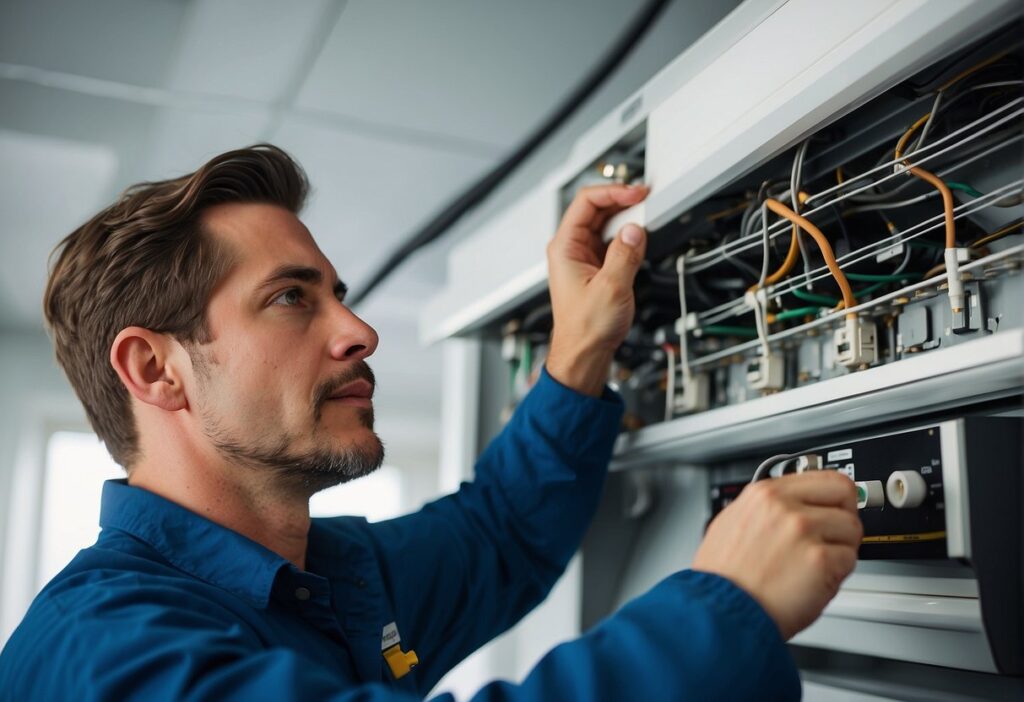Understanding Central HVAC
HVAC stands for Heating, Ventilation, and Air Conditioning. It is the technology responsible for maintaining comfortable indoor temperatures, proper airflow, and adequate humidity levels. Central air systems are commonly used in larger buildings where a consistent climate is crucial throughout the space.
In this article, we’ll explore the essential aspects of Central HVAC systems, from their basic operation to the various types and components involved. We will address common inquiries about central HVAC systems, focusing on their essential components, functionality, selection criteria, advantages and disadvantages, evaluation by consumer reports, and brand reliability.
Components of Central Air Systems
Central air systems consist of several key components:
- Thermostat: Serves as the control unit for temperature settings.
- Air Handler: Circulates air through the system.
- Furnace: Provides heating, often using gas or electricity.
- Air Conditioning Unit: Cools the air, typically located outside the building.
- Ductwork: Channels conditioned air throughout the building.
- Vents: Act as outlets for the air to enter each room.
The right combination of these elements ensures that our indoor environments remain comfortable year-round.
Types of HVAC Systems
There are several types of HVAC systems that we can choose from based on our needs:
- Split Systems: Have separate indoor and outdoor units.
- Packaged HVAC Systems: Combine heating and cooling into a single outdoor unit.
- Heat Pumps: Offer both heating and cooling capabilities through the transfer of heat.
- Furnaces and Boilers: Provide heat but do not cool the air.
- Ductless Mini-Split Systems: Ideal for spaces where traditional ductwork is not feasible.
Each type of system has its specific uses and benefits, which we must consider when selecting an HVAC system for our space.
Installation and Efficiency
When installing a central HVAC system, we consider not only the correct installation procedures but also the unit’s energy efficiency. It’s crucial to understand the Seasonal Energy Efficiency Ratio (SEER) ratings, as well as how heat pumps and furnaces integrate for optimal performance.
Installing HVAC Systems
A successful installation hinges on several key points. First, we ensure that the system’s size is appropriate for the home’s needs to avoid over or under-capacity issues. Second, the placement of both the indoor and outdoor units is carefully calculated for maximum efficiency. Proper ductwork is also critical; it must be sealed and insulated to prevent energy loss.
Energy Efficiency and SEER Ratings
Efficiency is measured using the SEER ratings, which indicate the amount of cooling output during a typical cooling-season divided by the total electric energy input. The higher the SEER rating, the more energy-efficient the unit is. It’s important for us to look for units with:
- A high SEER rating: Usually 15 or higher.
- Energy Star certification: This indicates superior energy efficiency.
Selecting highly efficient HVAC systems can result in lower energy consumption and may qualify us for rebates or incentives.
Heat Pump and Furnace Integration
Integrating a heat pump with a furnace can greatly enhance efficiency. During milder temperatures, the heat pump operates to maintain comfort, using electricity to move heat.
When it’s colder, the furnace kicks in, efficiently heating the home. By using both, we capitalize on the strengths of each system, reducing overall energy consumption.
- Furnace: Uses fuel for intense heat on colder days.
- Heat Pump: Transfers heat using a compressor, ideal for moderate climates.
Maintaining HVAC Health
To ensure our HVAC systems run efficiently and sustain optimal air quality, we prioritize regular maintenance and understand common issues that require attention.
Routine Maintenance and Servicing
We perform routine maintenance on our HVAC systems to prevent system failures and maintain indoor air quality. This includes:
- Filter replacement: Replacing air filters every 1-3 months to ensure clean airflow and reduce airborne contaminants.
- Duct cleaning: Make sure the duct cleaning as needed to reduce dust and improve overall air quality.
- System inspection: Scheduling annual inspections by a certified HVAC technician to ensure that all components meet regulatory standards and perform efficiently.
NATE certification is sought for technicians to guarantee expertise in maintenance.
Troubleshooting Common Problems

When troubleshooting common HVAC issues, we focus on:
- Thermostat issues: Checking if the thermostat is properly calibrated and functioning.
- Unusual noises: Identifying and addressing strange sounds that may indicate mechanical problems.
- Inconsistent temperatures: Investigating uneven heating or cooling to determine if there are airflow obstructions or system malfunctions.
Prompt repairs by a qualified HVAC contractor help us quickly resolve these issues.
Longevity and Service Plans
To extend the life of our HVAC systems and ensure consistent performance, we consider service plans that often include:
- Preferred scheduling: Getting priority service for maintenance and repairs.
- Cost savings: Benefiting from discounts on parts, repairs, and extended warranties.
- Regular check-ups: Taking advantage of pre-scheduled maintenance to avoid emergency situations.
We choose service plans that align with our needs and provide peace of mind through continued support.
Optimizing Climate Control
In optimizing climate control, we focus on integrating efficient thermostats and zoning systems, as well as enhancing comfort in both homes and offices. We ensure personalized comfort through smart programming and effective use of climate system components.
Thermostats and Zoning Systems
We employ advanced thermostats that enable precise temperature management and programming for different times of the day. These devices are typically connected to both the air handler (indoor unit) and the outdoor unit, allowing for seamless operation of the central HVAC system.
- Programmable Thermostats: These allow us to set temperature schedules, adjusting the climate based on our daily routines, thus conserving energy when we are away.
- Smart Thermostats: With these, we gain remote access to our HVAC settings via smartphones or computers, enabling adjustments on-the-go for optimal comfort.
Zoning systems play a crucial role in personalizing comfort within different areas of a building. By creating zones, we can control the climate of various sections independently.
- Single-zone systems: One thermostat controls the climate for the entire space.
- Multi-zone systems: Multiple thermostats manage different areas, allowing for personalized comfort and energy efficiency.
Enhancing Comfort in Homes and Offices
We strive to optimize the comfort levels within homes and offices by employing strategies that suit diverse preferences and utilizing the central HVAC system effectively.
- Air Distribution: Proper placement of vents and registers ensures even air distribution, avoiding hot or cold spots in rooms.
- Maintenance: Regular maintenance of the HVAC system, including filter replacement and system checks, helps maintain optimal performance and climate control.
By addressing these specific areas, we can significantly improve the efficacy of a central HVAC system and create a comfortable environment that caters to the varied needs of occupants in both residential and commercial settings.

Evaluating HVAC Options and Costs
Choosing the right heating, ventilation, and air conditioning (HVAC) system for your space is crucial, both for comfort and cost efficiency. We’ll guide you through determining the best system for your environment and show you how to approach the financial aspects of this important investment.
Determining the Right System for Your Space
When we consider the appropriate HVAC system for a space, whether it’s a residential setting or a commercial space, we need to evaluate several factors. The size of the space, the climate in which it’s located, and the building’s insulation are all pivotal points. A split-system air conditioner, which is the most common in residential settings, consists of an indoor unit and an outdoor unit. This design is known for its effectiveness and efficiency in moderate to warm climates.
For spaces without ductwork, or where traditional systems are impractical, we might recommend a ductless mini-split system. These systems offer the advantage of zoned temperature control and are relatively straightforward to install.
For larger commercial spaces, a packaged air conditioner, which houses all components in a single unit typically located on the roof or near the foundation, might be the most appropriate choice. These are designed to handle larger loads and can be customized based on facility needs.
Choosing a fuel source is also an important consideration. While electric HVAC systems are quite common due to their easy installation and maintenance, other buildings might be better suited for systems that use natural gas or boilers, depending on local utility costs and availability.
Cost Considerations and Budgeting
When we look at budgeting for an HVAC system, a clear understanding of upfront costs versus long-term savings is key. Here’s a simplified breakdown of potential costs:
- Split-system air conditioners: Typically range from $3,000 to $7,000, including installation.
- Ductless mini-split systems: Vary from $2,000 to $14,500, based on the number of indoor units needed.
- Packaged air conditioners: Might start around $3,500 for smaller units, with larger commercial systems costing upwards of $7,500.
Prices fluctuate based on capacity, efficiency ratings (SEER for cooling, AFUE for heating), brand, and labor costs in your region.
We advise establishing a budget early in the process, taking into account:
- The initial purchase price
- Installation expenses, which can vary significantly based on the complexity of the system and the structure of the building
- Ongoing maintenance costs
- Operating costs, impacted by the system’s efficiency and fuel source
- Potential utility rebates or government incentives for energy-efficient systems
Do remember that while a cheaper upfront cost may seem appealing, it typically translates into higher utility bills and more frequent repairs. Aim for a balance between the initial investment and the system’s long-term reliability and efficiency.
Frequently Asked Questions
What are the essential components of a central air conditioning system?
A central air conditioning system typically comprises a condenser, evaporator, compressor, expansion valve, and air handling unit. These components work in unison to circulate refrigerant and cool the indoor air.
How does a central HVAC system function?
A central HVAC system functions by extracting warm air from inside a building and cycling it through a series of processes that remove the heat and humidity. The air is then redistributed into the space as cooler, conditioned air.
What factors should be considered when choosing the best central air conditioner?
When selecting a central air conditioner, consider factors such as energy efficiency ratings, unit size relative to the space, brand reliability, maintenance requirements, and the system’s overall cost, including installation.
What are the advantages and disadvantages of decentralized HVAC systems?
Decentralized HVAC systems provide individual control of heating and cooling to separate areas, leading to personalized comfort and potentially reduced energy consumption. However, these systems may require more maintenance and can be less efficient in larger installations compared to centralized systems.
How do consumer reports evaluate HVAC systems and brands?
Consumer reports typically evaluate HVAC systems and brands based on reliability, customer satisfaction, efficiency ratings, warranty terms, and the cost-effectiveness of the units. Reviews then compare these factors to help consumers make informed decisions.
Which air conditioner brands are generally considered less reliable?
While brand reliability can fluctuate over time, some air conditioner brands may be critiqued by users and consumer reports for having higher failure rates, less durable components, or subpar customer service, leading them to be perceived as less reliable.

